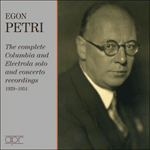Adelaïde is one of the finest of Beethoven’s early works, amounting really to a concert aria with piano, with two contrasting sections, which follow Friedrich Matthison’s poem of unrequited love, ‘Your friend wandered alone’, with its poetic conclusion of a flower blooming from the ashes of the lover’s heart, ‘One day, O Miracle’. Liszt remains very close to Beethoven’s text in all three versions of his transcription. In the second version, Liszt added a reflective coda in which he combined elements of the two parts of the song. In the final version, he discreetly extended Beethoven’s ending, but removed his coda and greatly elaborated it to form an optional cadenza, placed between the parts of the song. Recording technology should allow the listener to have or not to have the cadenza at will.
from notes by Leslie Howard © 1991
Adelaïde est une des plus belles des premières œuvres de Beethoven; elle équivaut vraiment à une aria de concert avec piano—avec deux sections contrastantes—qui suit le thème du poème de Friedrich Matthison sur l’amour non partagé, «Ton ami se promenait seul» avec sa conclusion poétique d’une fleur renaissant des cendres du cœur de l’amoureux, «Un jour, ô miracle». Liszt demeure très proche du texte de Beethoven dans les trois versions de sa transcription. Dans la seconde version, Liszt a ajouté une coda pensive dans laquelle il allie des éléments des deux parties du chant. Dans la version finale, il a allongé discrètement la conclusion de Beethoven, mais il a supprimé sa coda et l’a beaucoup travaillée pour former une cadence facultative, placée entre les parties du chant. La technologie de l’enregistrement devrait permettre à l’auditeur d’écouter ou non la cadence à volonté.
extrait des notes rédigées par Leslie Howard © 1991
Français: Alain Midoux
Adelaide ist eines der besten frühen Werke Beethovens und kommt wirklich einer Konzertarie mit Klavier gleich, mit zwei kontrastierenden Abschnitten, die Friedrich Matthisons Gedicht über unerwiderte Liebe, „Dein Freund wandert allein“, folgen und mit seinem poetischen Schluß von einer Blume, die aus der Asche des Herzens des Liebenden erblüht, „Eines Tages, O Wunder“. Bei allen drei Versionen seiner Transkription hält sich Liszt eng an Beethovens Text. In der zweiten Version fügte Liszt eine reflektive Koda hinzu, in der er Elemente der beiden Parts des Liedes verband. In der letzten Version erweiterte er diskret Beethovens Ende, enfernte jedoch seine Koda und arbeitete sie stark aus, um eine freiwillige Kadenz zu bilden, die zwischen die Parts des Liedes gesetzt wird. Die Aufnahmetechnik sollte es dem Hörer ermöglichen, die Kadenz nach Belieben zu haben oder nicht.
aus dem Begleittext von Leslie Howard © 1991
Deutsch: Gunhild Thompson


 Liszt: Complete Piano Music
Liszt: Complete Piano Music Egon Petri - The complete Columbia and Electrola solo and concerto recordings
Egon Petri - The complete Columbia and Electrola solo and concerto recordings
